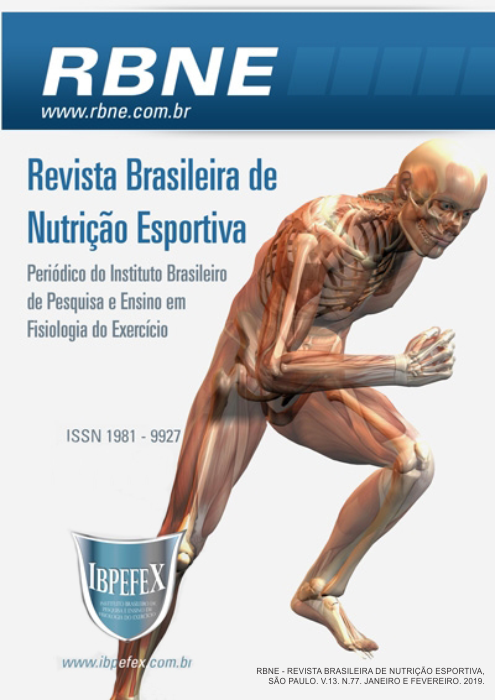Assessment of the level of knowledge and hydration in adolescents practicing soccer
Abstract
Introduction: The state of hydration is determinant for the practice of physical activities. Thus, assessing the knowledge and level of hydration is critical to avoiding health problems related to dehydration. Objective: To evaluate the level of knowledge and hydration of adolescents who are part of a soccer project. Materials and Methods: This is an observational and longitudinal study, with adolescents of the basic categories of UFJF football, male, aged between 13 and 17 years. Nutritional status was assessed according to BMI. The knowledge about hydration was evaluated through questionnaire and the level of hydration through weight and urine test (staining, pH and gravity), both before and after training. Results: Twenty-seven players were evaluated. According to urine color, 48.1% presented moderate dehydration. Regarding urine pH, 63% are acidic. About 80% of the density is hydrated. In the evaluation of the questionnaire it was identified that 81.5% of the players have the habit of moisturizing themselves during games with only cold water. They reported having some symptoms of dehydration as an intense thirst, in addition to having received basic guidance on hydration. Discussion: To diagnose the practice of hydration of the players allows an effective action for the correction of their habits, with strategies for the consumption of liquids before, during and after the games. Conclusion: It was verified that the players have a previous knowledge about hydration. However, they did not have a technical instruction on the subject, interfering in the level of hydration.
References
-Brasil. Ministério da Saúde. Protocolos do Sistema de Vigilância Alimentar e Nutricional -SISVAN na assistência à saúde. Brasília. Ministério da Saúde. 2008.
-Brito, I. S. S.; Brito C. J; Fabrini, S. P.; Marins, J. C. B. Caracterização das práticas de hidratação em karatecas do estado de Minas Gerais. Fitness & Performance Journal. Vol. 5. Núm. 1. p.24-30. 2006.
-Carvalho, T.; Mara, L. S. Hidratação e Nutrição no Esporte. Rev Bras Med Esporte. Vol. 16. Vol. 2. p. 144-148. 2010.
-Castro, P. H. C.; Freitas, J. V.; Santos, J. N.R. S.; Cruz, R.; Werneck, A. S.; Bastos, L. L.A. G. Caracterização do conhecimento e dos hábitos de hidratação de jovens atletas de atletismo. Coleção de Pesquisa em Educação Física. Vol. 12. Núm. 3. p. 51-58. 2013.
-Cruz, M.; Cabral, C. A.; Marins, J. C. Nível de conhecimento e hábitos de hidratação dos atletas de mountain bike. Fitness & Performance Journal. Vol. 8. Núm. 2. p. 79-89. 2009.
-Drumond, M. G.; Carvalho, F. R.; Guimarães, E. M. A. Hidratação em atletas adolescentes -Hábitos e nível de conhecimento. Revista Brasileira de Nutrição Esportiva. São Paulo. Vol. 1. Núm. 2. p. 76-93. 2007. Disponível em: <http://www.rbne.com.br/index.php/rbne/article/view/20/19>
-Godois, A. M.; e colaboradores. Perda hidrica e prática de hidratação em atletas de futebol. Rev Bras Med Esporte. Vol. 20. Num. 1. p. 47-50. 2014.
-Gomes, L. S.; Barroso, S. D. S.; Gonzaga, W. D. S.; Prado, E. S. Estado de hidratação em ciclistas após três formas distintas de reposição hídrica. Vol. 22. Núm. 3. p.89-97. Revista Brasileira de Ciência e Movimento. Vol. 22. Num. 3. p. 89-97. 2014.
-Kac, G.; Velásquez-Meléndez, G. A transição nutricional e a epidemiologia da obesidade na América Latina. Cadernos de Saúde Pública. Vol. 19. Num. 1. p. S4-S5. 2003.
-Kenney, W. L. Requerimentos nutricionais de água e sódio para adultos ativos. Nutrição no Esporte. Núm. 41. 2004.
-Machado-Moreira, C. A.; e colaboradores. Hidratação durante o exercício: a sede é suficiente? Rev Bras Med Esporte. Vol. 12. Num. 6. p. 405-409. 2006.
-Magarey, A. M.; Daniels, L. A.; Boulton, T. J. Prevalence of overweight and obesity in Australian children and adolescents: reassessment of 1985 and 1995 data against new standard international definitions. Medical Journal of Australia. Vol. 174. Num. 11. p.561-564. 2001.
-Marins J. Hidratação na atividade física e no esporte: equilíbrio hidromineral. Várzea Paulista. Fontoura. 2011.
-Mendes, M. J. F. L.; Alves, J. G. B.; Alves, A. V.; Siqueira, P. P.; Freire, E. F. C. Associação de fatores de risco para doenças cardiovasculares em adolescentes e seus pais. Revista Brasileira de Saúde Materno Infantil. Vol. 6. Num. 1. p. S49-S54. 2006.
-Nuccio, R. P.; e colaboradores. Fluid Balance in Team Sport Athletes and the Effect of Hypohydration on Cognitive, Technical, and Physical Performance. Sports Med. Vol. 47. p. 1951-1982. 2017.
-Ostojic, S; Mazic, S. Effects of a Carbohydrate-Electrolyte Drink on Specific Soccer Tests and Performance. Journal of Sports Science & Medicine. Vol. 1. Num. 2. p. 47-53. 2002.
-SBME. Diretriz da Sociedade Brasileira de Medicina do Esporte. Modificações Dietéticas, Reposição Hídrica, Suplementos Alimentares e Drogas: Comprovação de Ação ergogênica e Potenciais Riscos para à Saúde. Rev Bras Med Esporte. Vol. 15. Num. 3. p. 2-12. 2009.
-Silva, M. R.; e colaboradores. Efeito de suplemento hidroeletrolítico na hidratação de jogadores juniores de futebol. Rev Bras Med Esporte. Vol. 17. Num. 5. p. 339-343. 2011.
Authors who publish in this journal agree to the following terms:
- Authors retain the copyright and grant the journal the right of first publication, with work simultaneously licensed under the Creative Commons Attribution License BY-NC which allows the sharing of the work with acknowledgment of the authorship of the work and initial publication in this journal.
- Authors are authorized to enter into additional contracts separately for non-exclusive distribution of the version of the work published in this journal (eg, publishing in institutional repository or book chapter), with acknowledgment of authorship and initial publication in this journal.
- Authors are allowed and encouraged to post and distribute their work online (eg, in institutional repositories or on their personal page) at any point before or during the editorial process, as this can bring about productive change as well as increase impact and impact. citation of published work (See The Effect of Free Access).






